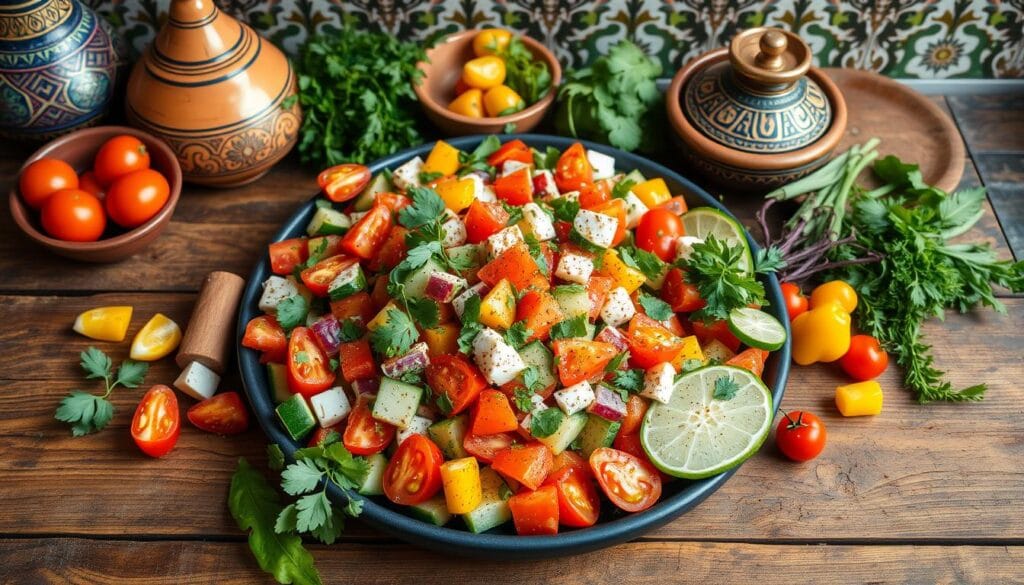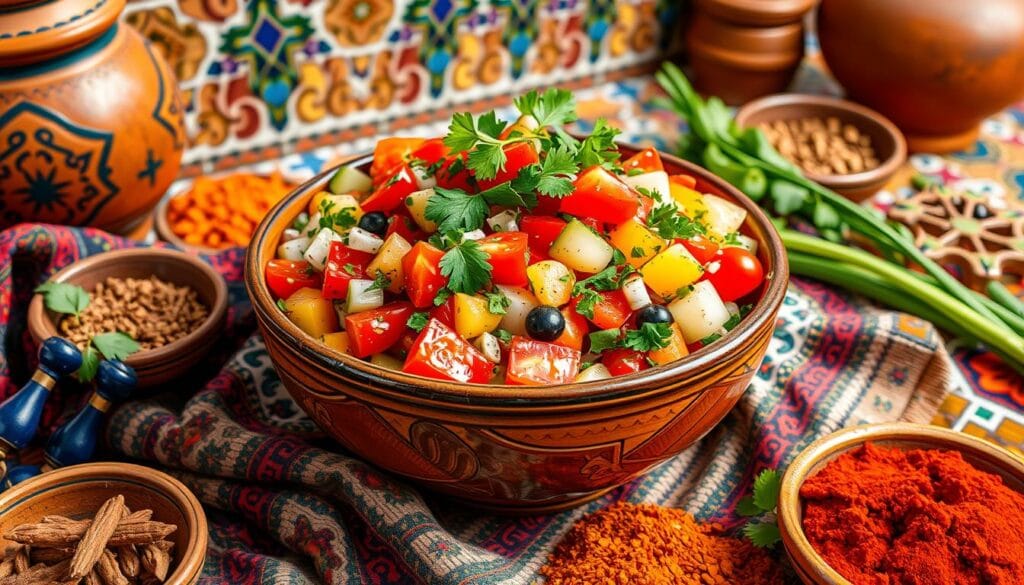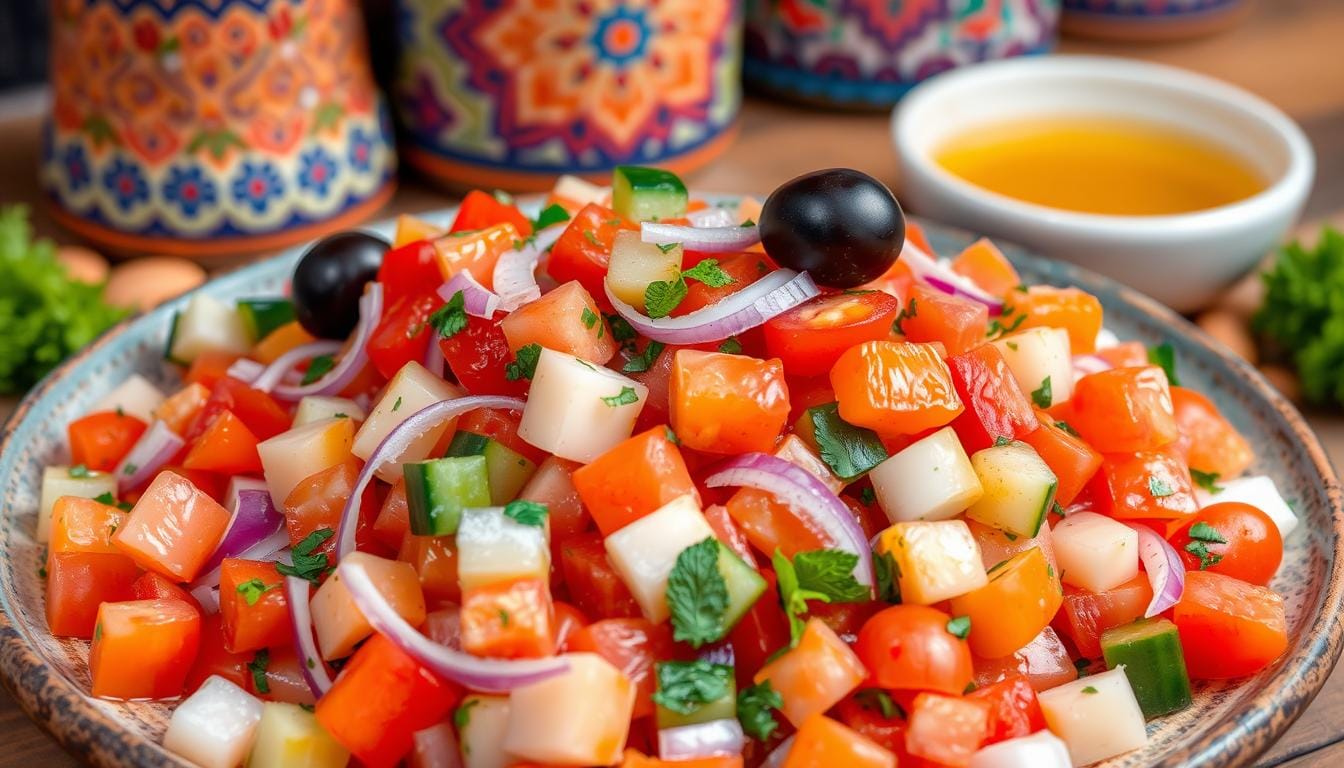As I step into my kitchen, the vibrant flavors of a Moroccan salad come to life with the smell of fresh veggies and spices, reminiscent of Marrakech’s bustling markets. My grandmother often spoke of Moroccan food’s rich history and flavors, sparking my passion for Moroccan cooking.
Now, I’m on a journey to explore Moroccan salads, dishes bursting with nutrients and fresh ingredients. Loved by health enthusiasts worldwide, they blend spices and tradition, offering a true taste of the Mediterranean.
Introduction to Traditional Moroccan Salad
Moroccan cuisine is a mix of Middle Eastern and Mediterranean flavors. It’s known for its tasty and healthy salads. These dishes have been a big part of North African meals for centuries.
History of Moroccan Cuisine
The history of Moroccan food goes back to the Berber, Arab, and Moorish cultures. Over time, Moroccan chefs mixed flavors from the Mediterranean, Middle East, and Africa. This created a unique and exciting food experience.
Cultural Significance in North African Dining
In North Africa, salads are more than just sides. They are the heart of many meals. They show off the area’s rich produce and spices. Moroccan salads are key in both big celebrations and small family dinners.
“Moroccan cuisine is a tapestry of flavors, where the warmth of the Sahara, the coolness of the Atlas Mountains, and the freshness of the Atlantic coast all come together in a symphony of taste.”
– Chef Farid Zair, author of “The Flavors of Morocco”
| Moroccan Cuisine | Middle Eastern Food | Mediterranean Diet |
|---|---|---|
| Rich in spices, herbs, and slow-cooked dishes | Emphasis on shared plates, grilled meats, and aromatic rice dishes | Focus on plant-based foods, olive oil, and seafood |
| Influenced by Berber, Arab, and Moorish culinary traditions | Diverse range of flavors from the Levant, Persia, and Turkey | Rooted in the cuisines of Greece, Italy, and Spain |
| Vibrant salads featuring local produce and preserved lemons | Signature dishes like hummus, falafel, and shawarma | Signature dishes like Greek salad, ratatouille, and paella |
Essential Ingredients for an Authentic Moroccan Salad
Making a real Moroccan salad means picking the right mix of fresh ingredients. At its core, it’s about the vegetable salad and moroccan chickpea salad. Together, they create a mix of tastes and textures.
The base of a Moroccan salad is colorful, fresh veggies. You’ll find big tomatoes, crunchy bell peppers, sweet carrots, and cool cucumbers. These add a nice crunch and juiciness.
The salad also gets protein from chickpeas (or moroccan chickpea salad) and lentils. These legumes make the salad filling and add a nutty taste and creamy feel.
No Moroccan salad is complete without its herbs and spices. Cilantro, parsley, and mint bring a fresh taste. Warm spices like cumin, paprika, and cinnamon add depth.
The salad gets a special touch from olives, lemons, and a bit of olive oil. These add a salty, tangy, and rich flavor, balancing everything out.
With the right ingredients, you can make an authentic Moroccan salad. It will take you to the lively markets and streets of North Africa.
The Art of Preparing a Perfect Moroccan Salad
Making a Moroccan salad is a fun journey. It involves cutting veggies right, using traditional seasonings, and mixing ingredients well. These steps help you enjoy the bright tastes of North African food.
Proper Vegetable Cutting Techniques
The base of a Moroccan salad is in cutting veggies right. Here’s how to get the right look and feel:
- Chop tomatoes, cucumbers, and bell peppers into small pieces.
- Cut onions and radishes thinly for a nice flavor mix.
- Grate carrots finely for a soft, shredded texture.
Traditional Seasoning Methods
Moroccan salads are known for their strong, tasty flavors. Use these methods to get that Moroccan taste:
- Season with cumin, paprika, and a bit of cayenne pepper.
- Use a dressing of olive oil, lemon juice, and honey.
- Add fresh parsley and mint for extra freshness.
Optimal Ingredient Ratios
Finding the right mix of ingredients is key to a great Moroccan salad. Here’s a guide to balance your salad:
| Ingredient | Ratio |
|---|---|
| Tomatoes | 1 part |
| Cucumbers | 1 part |
| Bell Peppers | 1/2 part |
| Onions | 1/4 part |
| Carrots | 1/4 part |
| Radishes | 1/4 part |
By using these tips and ratios, you can make a Moroccan salad recipe that truly captures North African flavors. Enjoy the vibrant, balanced, and satisfying taste of a perfect Moroccan salads.
Health Benefits and Nutritional Value
Adding a Mediterranean diet with vegetable salads and Moroccan chickpea salad boosts health. These salads are tasty and packed with nutrients.
Moroccan salads are full of vitamins and minerals. They have antioxidants from fresh veggies like tomatoes and leafy greens. These antioxidants fight off harmful free radicals, keeping us healthy.
These salads also have heart-healthy fats from olive oil and nuts. They’re good for your heart. Plus, they’re high in fiber, helping your digestion and keeping you full, which can help with weight control.
| Nutrient | Amount per Serving | % Daily Value |
|---|---|---|
| Calories | 250 kcal | 12.5% |
| Total Fat | 15 g | 23% |
| Carbohydrates | 25 g | 8% |
| Fiber | 7 g | 25% |
| Protein | 8 g | 16% |
| Vitamin A | 120% DV | – |
| Vitamin C | 150% DV | – |
| Iron | 15% DV | – |
Choosing the mediterranean diet with vegetable salads and Moroccan chickpea salad is healthy. They’re full of nutrients, making them great for your well-being.
Regional Variations of Moroccan Salad
The world of Moroccan cuisine is full of different flavors from each region. Each area, from the sunny coast to the mountains and deserts, has its own special salads. These dishes show the amazing variety of local tastes.
Coastal Region Adaptations
By the Moroccan coast, salads are filled with fresh seafood. You might find grilled shrimp or seared tuna in them. The dressings often have a hint of citrus, which goes well with the sea’s flavor.
Mountain Area Variations
In the Moroccan mountains, salads are all about hearty, earthy tastes. Roasted veggies like eggplant and bell peppers are key, dressed in creamy tahini sauce. Toasted nuts and seeds add a nice crunch to these mountain dishes.
Desert-Inspired Versions
The Moroccan deserts have also influenced salad traditions. Salads here use ingredients like dates, figs, and olives, which grow well in dry places. The dressings might include spices like cumin and cinnamon, bringing the desert’s warmth to the table.
Exploring Moroccan salads from different regions is a journey through taste and culture. Each salad tells a story of the land, showing how local geography and climate shape the flavors. It’s a true celebration of moroccan salads.
Essential Spices and Herbs in Moroccan Salad Making
Moroccan cuisine is known for its bold flavors. The traditional Moroccan salad is a perfect example. It’s made with a mix of spices and herbs that add unique tastes and smells.
Cumin is a key spice, giving the salad an earthy, nutty flavor. It balances the salad’s acidity and adds depth. Paprika adds a smoky, sweet taste, making the salad even more flavorful.
Fresh herbs are also important. Cilantro brings a bright, citrusy flavor. Mint adds a cool, herbal taste that balances the salad’s flavors.
Other spices like cinnamon and coriander can also be used. Cinnamon adds a warm, sweet taste. Coriander gives a lemony flavor. These ingredients make Moroccan salad special, offering a true taste of North Africa.

Learning about spices and herbs in Moroccan salad making is key. It helps home cooks make a dish that feels like a trip to Morocco’s markets and streets.
Serving and Presentation Tips
Serving a Moroccan salad right can make all the difference. Moroccan cuisine is known for its bright colors, strong spices, and deep cultural roots. The way you serve and present a Moroccan salad is key to a great dining experience.
Traditional Serving Vessels
In Middle Eastern food culture, Moroccan salads are served in special vessels. These can be fancy ceramic bowls or hand-woven baskets. They not only show off the salad but also highlight Moroccan craftsmanship.
Garnishing Techniques
Chefs and home cooks use many garnishing techniques to make a Moroccan salad look good. Adding fresh herbs like mint or parsley gives a pop of color. Toasted nuts or seeds add a nice crunch. Colorful vegetable slices or edible flowers can turn a simple salad into a feast for the eyes.
Using traditional serving methods and garnishing techniques lets you dive into Moroccan food‘s rich heritage. It makes a Moroccan salad not just tasty but also a feast for the eyes. This celebrates the heart of North African cuisine.
Pairing Your Moroccan Salad with Other Dishes
Enjoying a Moroccan salad opens up endless pairing options. This vibrant cuisine combines spices, herbs, and fresh produce. It’s perfect for a well-rounded meal.
Pair your salad with classic dishes to truly enjoy Moroccan cuisine. A tagine, a slow-cooked stew, contrasts nicely with the salad’s crunch. The tagine’s rich flavors complement the salad’s tanginess, creating a delightful taste experience.
For a lighter option, try pairing with couscous. The fluffy couscous lets the salad’s flavors stand out. Adding roasted vegetables or dried fruits to the couscous can enhance the dish.
| Moroccan Salad Pairing | Why It Works |
|---|---|
| Tagine (Slow-Cooked Meat and Vegetable Stew) | The rich, aromatic flavors of the tagine complement the bright, tangy notes of the salad, creating a harmonious balance. |
| Couscous | The fluffy, steamed semolina provides a versatile base that allows the salad’s vibrant flavors to shine. |
| Moroccan Mint Tea | The refreshing and fragrant tea helps to cleanse the palate and enhance the overall Moroccan dining experience. |
Don’t forget to serve your salad with Moroccan mint tea. This tea refreshes the palate and complements the salad’s bold flavors.
Pairing your salad with traditional dishes and drinks creates a memorable dining experience. It celebrates North Africa’s rich culinary heritage.

Storage Tips and Make-Ahead Options
Keeping a Moroccan salad fresh and flavorful is key. Whether it’s for a dinner party or meal prep, knowing how to store and prepare ingredients is crucial.
Proper Storage Methods
Moroccan salads are best eaten soon after making. But, with a few tips, you can keep them fresh longer. Store your salad in an airtight container in the fridge for up to three days. Try not to let the veggies sit in the dressing too long to avoid sogginess.
To store longer, prep the salad parts ahead. Keep the veggies, dressing, and garnishes separate in the fridge. When you’re ready, mix everything together. Your Moroccan vegetable salad will taste as fresh as the day you made it.
Ingredient Prep Guidelines
- Wash and chop all veggies well, making sure they’re dry before storing.
- Make the dressing ahead and keep it in a sealed container.
- Roast or sauté proteins like chickpeas or chicken, then chill them before adding to the salad.
- Toast nuts and seeds to boost their taste, then store them in an airtight container.
- Chop herbs and keep them in the fridge, wrapped in a damp paper towel or in a small container with water.
By following these tips, you can enjoy a Moroccan salad recipe anytime. You won’t have to worry about losing quality or freshness.
Common Mistakes to Avoid When Making Moroccan Salad
Making a Moroccan salad can be an art. But, it’s easy to make mistakes. Avoid these common errors to make a delicious moroccan salad recipe.
Over-Seasoning the Salad
Spices and herbs are key in Moroccan cuisine. But, don’t overdo it. Start with a little and add more as needed for the right taste.
Neglecting Texture Variety
Good moroccan salads have different textures. Add crunchy veggies and chewy dried fruits for a great experience.
Forgetting the Acidity
A bit of lemon juice or vinegar is crucial. It brings out the flavors. Without it, your salad might not taste as good.
| Common Mistake | Solution |
|---|---|
| Over-seasoning | Start with a light touch and gradually build up the flavors |
| Neglecting texture variety | Include a range of textures, from crunchy vegetables to chewy dried fruits |
| Forgetting the acidity | Incorporate lemon juice or vinegar to balance the flavors |
Avoid these mistakes to make a moroccan salad recipe that feels like Marrakech. Enjoy the flavors of Moroccan cuisine in your salad.
Conclusion
We’ve taken a journey through the world of Moroccan salads. We’ve seen how they reflect the rich history and culture of North Africa. From the coast to the mountains, Moroccan salads show the diversity and creativity of the people.
The key ingredients, like crisp veggies and spices, blend together beautifully. This creates a taste experience that excites your senses. Plus, these salads are full of nutrients, making them great for your health.
Now, it’s your turn to make your own Moroccan salads. Remember to respect the tradition and try new things. Share your creations with others. This way, you honor Morocco’s culinary legacy and add to the global food culture.
FAQ
What is a Moroccan salad?
A Moroccan salad is a colorful and tasty dish from Moroccan cuisine. It mixes fresh veggies, herbs, legumes, and spices. This mix creates a unique and authentic North African flavor.
What are the key ingredients in a traditional Moroccan salad?
Key ingredients include tomatoes, cucumbers, bell peppers, and onions. Chickpeas, olives, and spices like cumin, paprika, and cilantro are also important.
What is the cultural significance of Moroccan salads?
Moroccan salads are a big part of the country’s food traditions. They are enjoyed daily or on special occasions. They show the diverse flavors and influences in Moroccan cuisine.
How do you prepare an authentic Moroccan salad?
To make a real Moroccan salad, you need to cut veggies right, season them traditionally, and mix ingredients well. This ensures the right flavors and textures.
What are the health benefits of Moroccan salads?
Moroccan salads are full of healthy stuff like veggies, legumes, and herbs. They are great for the Mediterranean diet. They have lots of vitamins, minerals, and antioxidants.
Are there regional variations of Moroccan salads?
Yes, Moroccan salads vary by region. Coastal, mountain, and desert areas each have their own twist. This is due to local ingredients and traditions.
What are the essential spices and herbs used in Moroccan salad making?
Important spices and herbs include cumin, paprika, coriander, mint, and parsley. They give the salad its unique taste.
How should Moroccan salads be served and presented?
Serve Moroccan salads in traditional dishes. Use creative garnishes to show off their colors and textures.
What dishes pair well with Moroccan salads?
Moroccan salads go well with dishes like couscous, tagines, and grilled meats. They make a complete and authentic meal.
How can Moroccan salads be stored and prepared in advance?
Store Moroccan salads right to keep them fresh and tasty. Follow prep tips for easy meal planning and entertaining.
What are some common mistakes to avoid when making Moroccan salad?
Don’t over-season, use the wrong ingredients, or cut veggies wrong. These mistakes can ruin your salad’s taste and authenticity.



